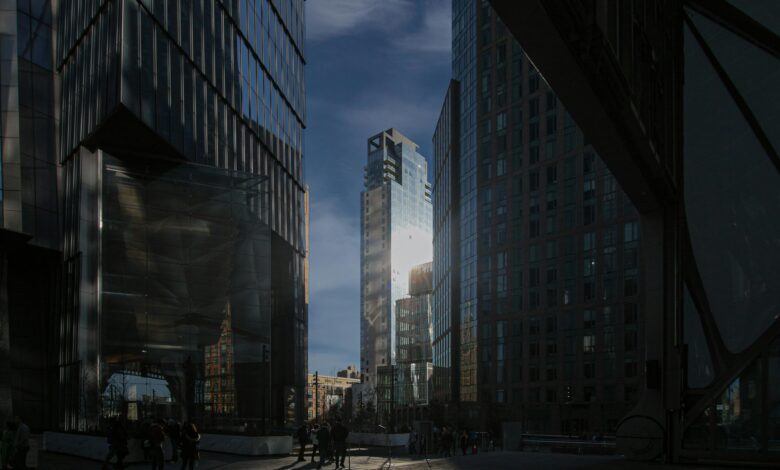Urban Synergy: The Rise of Co-Living and Co-Working Spaces Transforming City Life

In recent years, urban landscapes have undergone a profound transformation, reshaping not just the way we live but also how we work. The rise of co-living and co-working spaces reflects a fundamental shift in societal values, where community, collaboration, and flexibility take precedence over traditional models of living and working. As cities grow denser and the demands of modern life evolve, these innovative spaces have emerged as a solution to the challenges of urbanization, offering residents and professionals alike a vibrant ecosystem that fosters connection and creativity. This article delves into the urban evolution that has paved the way for co-living and co-working spaces, explores the myriad benefits that are driving this trend, and envisions a future where these dynamic environments redefine the very fabric of urban life. Join us as we navigate this exciting frontier, uncovering how co-living and co-working are not just trends, but catalysts for a more integrated and collaborative urban experience.
- 1. "Urban Evolution: The Shift Towards Co-Living and Co-Working Spaces"
- 2. "Community and Collaboration: The Benefits Driving the Co-Living Trend"
- 3. "Future of Work and Living: How Co-Working Spaces Are Redefining Urban Life"
1. "Urban Evolution: The Shift Towards Co-Living and Co-Working Spaces"
In recent years, urban landscapes have undergone a significant transformation, reflecting broader societal changes and evolving lifestyles. The rise of co-living and co-working spaces can be traced to a confluence of factors, including the increasing cost of living, the gig economy, and a growing desire for community and collaboration among city dwellers.
As cities become more densely populated, the traditional models of living and working are being challenged. High rents and limited space have led to a rethinking of how individuals approach housing. Co-living spaces offer a solution by providing affordable, flexible living arrangements that foster community among residents. These shared environments often come equipped with communal kitchens, lounges, and social events, encouraging interaction and collaboration among tenants. This trend is particularly appealing to millennials and Gen Z, who prioritize experiences and connection over traditional markers of success, such as homeownership.
Simultaneously, the nature of work is evolving, driven by technological advancements and changes in employment structures. The gig economy has created a workforce that values flexibility and autonomy, leading to a surge in co-working spaces. These environments cater to freelancers, remote workers, and startups, offering not only a desk but also networking opportunities and a vibrant community atmosphere. Co-working spaces are designed to inspire creativity and collaboration, often featuring open layouts, modern amenities, and a range of resources that support entrepreneurial endeavors.
Moreover, the COVID-19 pandemic has accelerated these trends, as remote work became a necessity for many. The subsequent shift in workplace culture has reinforced the appeal of co-working spaces, which provide a sense of normalcy and interaction that home offices often lack. Similarly, the demand for co-living arrangements has increased, as individuals seek out supportive environments that mitigate the isolation brought on by social distancing measures.
As urban areas continue to evolve, the integration of co-living and co-working spaces represents not just a trend, but a fundamental shift in how people engage with their environments. These spaces reflect a growing recognition of the importance of community, collaboration, and adaptability in an increasingly complex urban landscape. They signify a move towards more sustainable and inclusive models of living and working, where individuals can thrive both personally and professionally in a shared context.
2. "Community and Collaboration: The Benefits Driving the Co-Living Trend"
As urban populations continue to swell, the need for affordable housing and flexible working environments has spurred the rise of co-living and co-working spaces. At the heart of this trend lies a powerful emphasis on community and collaboration, which serve as key benefits attracting individuals from diverse backgrounds. These spaces foster a sense of belonging, allowing residents and workers to connect with like-minded individuals, share experiences, and cultivate relationships that extend beyond mere convenience.
Co-living spaces are designed to promote interaction among residents through communal areas such as kitchens, lounges, and event spaces. This intentional layout encourages socializing, collaboration, and the sharing of ideas, creating a vibrant atmosphere that can alleviate feelings of isolation often experienced in traditional living arrangements. By living in close proximity to others, individuals can tap into a network of support, making it easier to forge friendships, collaborate on projects, or even share resources like tools and appliances.
Moreover, co-working spaces enhance this collaborative spirit by providing a dynamic environment where professionals can connect, network, and share knowledge. The rise of remote work has led to a growing demand for flexible office solutions that blend work and social interactions. Co-working spaces often host workshops, networking events, and community-building activities, further enriching the experience for their members. This synergy not only boosts individual productivity but also fosters innovation as diverse groups come together to brainstorm and tackle challenges.
The benefits of community and collaboration extend beyond immediate social interactions; they contribute to personal and professional growth. Individuals in co-living and co-working environments often find themselves exposed to a multitude of perspectives and skill sets, broadening their horizons and enhancing their problem-solving capabilities. In this way, the co-living and co-working trend is not just about sharing space; it’s about cultivating a rich tapestry of interactions that empower individuals to thrive in both their personal and professional lives.
As cities continue to evolve, the allure of community-driven living and working will likely remain a significant factor influencing urban development, shaping the future of how we inhabit our shared spaces.
3. "Future of Work and Living: How Co-Working Spaces Are Redefining Urban Life"
As urban areas continue to evolve, the traditional boundaries between work and living spaces are increasingly blurred, leading to a transformative shift in how we perceive our environments. Co-working spaces have emerged as a pivotal element in this evolution, reflecting a new philosophy of work that embraces flexibility, collaboration, and community. This shift is not just a response to the rise of remote work, but a fundamental rethinking of how urban life is organized.
The future of work in urban settings is characterized by the demand for adaptable environments that cater to diverse needs. Co-working spaces offer more than just a desk; they provide a dynamic ecosystem where professionals from various industries can connect, collaborate, and innovate. These spaces are designed to foster interaction, allowing for the exchange of ideas and resources that can lead to creative solutions and entrepreneurial ventures. As the gig economy continues to expand and more individuals seek autonomy in their careers, co-working spaces provide an essential infrastructure that supports this new way of working.
Moreover, the design and location of co-working spaces reflect a growing emphasis on community and sustainability. Many of these spaces are situated in vibrant neighborhoods, making them accessible and integrated into the urban fabric. They often prioritize eco-friendly practices, such as green building materials and energy-efficient systems, appealing to a socially conscious workforce. This alignment with sustainability not only attracts environmentally-minded professionals but also contributes to the overall well-being of urban areas.
As co-working spaces gain popularity, they are also influencing the residential landscape. The rise of co-living arrangements, where individuals share communal living spaces alongside co-working facilities, further blurs the lines between home and work. This trend caters to a new generation of urban dwellers who value experiences and community over traditional ownership. By merging living and working environments, co-living and co-working spaces create a holistic lifestyle that promotes work-life balance and fosters a sense of belonging.
Looking ahead, the integration of technology in co-working spaces will likely enhance their appeal, enabling seamless connectivity and smart features that cater to the evolving needs of urban professionals. As artificial intelligence, virtual reality, and other innovations become more prevalent, these spaces will continue to adapt, offering tailored experiences that enhance productivity and collaboration.
In summary, co-working spaces are not just reshaping the way we work; they are redefining urban life itself. By promoting flexibility, community, and sustainability, they are setting the stage for a future where the interplay between work and living environments fosters creativity, innovation, and a deeper connection to the urban landscape. As cities adapt to these changes, the potential for a more integrated and fulfilling urban experience becomes increasingly attainable.
In conclusion, the rise of co-living and co-working spaces signals a transformative shift in urban life, driven by the growing desire for community, collaboration, and flexibility in an increasingly interconnected world. As cities evolve to meet the needs of modern inhabitants, these innovative spaces offer not only a solution to the challenges of urban density and cost of living but also a vibrant environment that fosters creativity and connection. The benefits of co-living extend beyond mere affordability; they cultivate a sense of belonging and shared purpose among residents, while co-working spaces redefine traditional work dynamics, promoting productivity and networking opportunities. As we look to the future, it is clear that these trends will continue to shape our urban landscapes, making cities more inclusive and dynamic. Embracing the principles of co-living and co-working can lead to a more sustainable, collaborative, and resilient urban experience, ultimately enhancing the quality of life for all city dwellers. The rise of these spaces is not just a trend; it represents a fundamental shift in how we live and work together in our ever-evolving urban environments.





